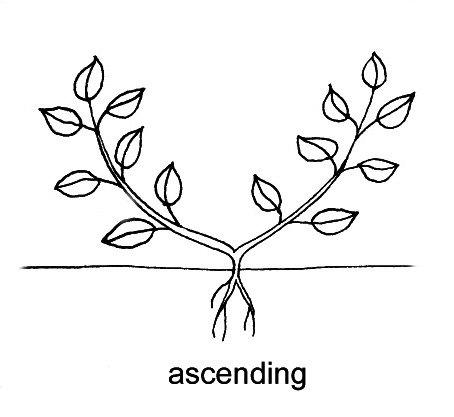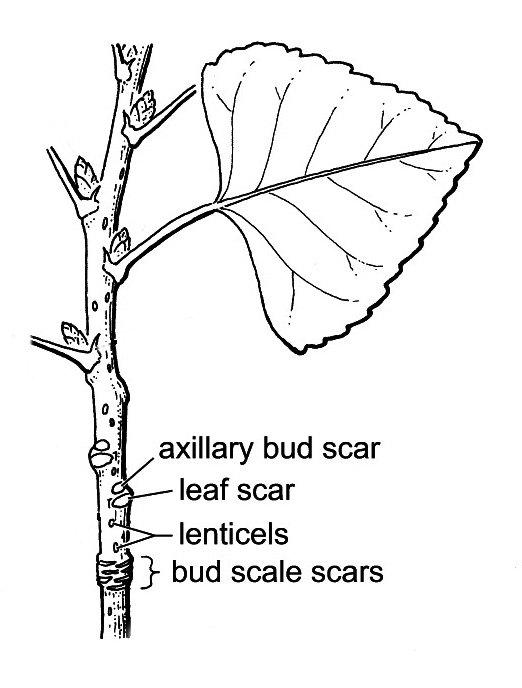|
|
 |
Key to DelphiniumView taxon page for Delphinium
(For a list of species in Delphinium, use the above link.) Jepson Manual glossary definitions can be seen by moving your cursor over words underlined with dots. 1. Plant with all the following: sepals pink to deep rose-pink; fruit erect  Upright; vertically oriented. ; pedicels  Stalk of an individual flower in an inflorescence, or the corresponding structure in fruit. ± ascending  Curving or angling upward from base, or about 30-60 degrees less than vertical or away from axis of attachment. , hairs glandular, yellow; angle between claw and blade  Expanded portion of a leaf, petal, or other structure, generally flat but sometimes rolled, cylindric, wavy, or cupped. on lower petals > 130°; s SN, w edge DMoj ..... D. purpusii 1' Plant with at least 1 exception to character states at 1. 2. Leaf blade base tapered  Gradually (not abruptly) narrower or smaller at base or tip. , lobes  1. A major expansion or bulge, such as on the margin of a leaf, sepal, or petal, or on the surface of an ovary. 2. The free tips of otherwise fused structures, such as sepals or petals; larger than teeth. few, < 50% to petiole  Leaf stalk, connecting leaf blade to stem; sometimes more or less indistinct. ; serpentine streambanks, chaparral, grassland ..... D. uliginosum 2' Leaf blade base cordate  Heart-shaped; often pertaining to a leaf in which the blade base on both sides of the petiole is rounded and convex. , truncate  Abruptly (not gradually) narrower or smaller at base or tip, as if cut straight across or nearly so. , or rounded, lobes (3)5–many, > 50% to petiole; generally not on serpentine 3. Sepals ± red or yellow; blade of lower petals angled 140–180° to claw, hairs ± 0 to naked eye 4. Seed without inflated collar; fruit ± straight; plants of ± dry sites; SCoR, SW, w edge DSon ..... D. cardinale 4' Seed with inflated collar at widest end: fruit curved; plants of moist sites; SCoRO & n 3' Sepals generally variously blue, occasionally white, green-white, lavender, maroon, purple, or pink but not red or yellow; blade of lower petals angled 60–130° to claw, hairs apparent to naked eye 6. Plant with all the following: inflorescence ± 1-sided; flower generally on and after 15 June; 1800–2600 m; stem generally 7–40(60) cm; pedicels ascending; seed winged, without inflated collar at widest end; root < 5 cm; CaRH, n&c SNH, Wrn ..... D. depauperatum 6' Plant with 2 or more exceptions to character states at 6. 7. Seed with inflated collar at widest end, unwinged; fruit ± curved; inflorescence in mid-flower with generally < 6 flowers on main axis or oldest open-flowered pedicels generally > 25 mm and > 2 × youngest 8. Most leaves on distal 2/3 of stem; stem (40)50–120(180) cm; flowers on main inflorescence axis generally > 15 9. Leaf lobe  1. A major expansion or bulge, such as on the margin of a leaf, sepal, or petal, or on the surface of an ovary. 2. The free tips of otherwise fused structures, such as sepals or petals; larger than teeth. tips crenate  Pertaining to margins with shallow, rounded teeth, between which are usually acute sinuses (i.e., scalloped) ; n CCo, n SnFrB (Marin Co.) ..... D. bakeri 8' Most leaves on proximal 2/3 of stem; stem < 50(90) cm; flowers on main inflorescence axis generally < 20 10. Sepals dark blue-purple (generally faded, mottled on herbarium specimens), puberulent  Minutely hairy. abaxially, generally not reflexed  Abruptly bent or curved downward or backward. ; proximal stem hairy; lower petal blades 6–11 mm ..... D. decorum 10' Sepals generally bright blue to white or pink (generally neither faded nor mottled on herbarium specimens), generally glabrous, generally reflexed; proximal stem glabrous to puberulent; lower petal blades 3–11 mm (if sepals ± purple, puberulent abaxially, not reflexed, then proximal stem ± glabrous or lower petal blade < 6 mm) 12' Leaf not fleshy; plant not restricted to moist talus slopes 13. Leaf with >= 6 lobes > 50% to petiole, < 7 mm wide; pedicels glabrous or puberulent; SNH and n ..... D. nuttallianum 13' Leaf with <= 5 lobes > 50% to petiole, generally > 7 mm wide; pedicels glabrous to glandular or glandular-puberulent (if > 5 lobes > 50% to petiole, then pedicels puberulent); SN, SCoRI and s (also s KR, s CaR for Delphinium gracilentum) 14. Terminal leaf  Organ arising from a stem, generally composed of a stalk (petiole) and a flat, expanded, green, photosynthetic area (blade); distinguished from a leaflet by the presence in its axil of a bud, branch, thorn, or flower; sometimes with lateral, basal appendages (stipules); either simple (toothed, lobed, or dissected but not divided into leaflets) or compound (divided into leaflets). lobe widest above middle; pedicel  Stalk of an individual flower in an inflorescence, or the corresponding structure in fruit. at 70–90° angle to axis; leaf lobes generally 5 ..... D. gracilentum 14' Terminal leaf lobe widest near middle; pedicel at generally < 70° angle to axis; leaf lobes 3–10 ..... D. patens 15. Lobes of proximal leaves generally > 1.5 cm wide; basal  At or near the base of a plant or plant part. Especially said of leaves clustered near the ground or of a placenta confined to the base of an ovary. , proximal cauline leaves generally cut < 80% to petiole – SCoRO, SW (except ChI) ..... subsp. hepaticoideum 15' Lobes of proximal leaves generally < 1.5 cm wide; basal (if present), proximal cauline leaves generally cut > 80% to petiole 7' Seed generally without inflated collar (except Delphinium andersonii), winged or not; fruit ± straight; inflorescence in mid-flower with generally > 6 flowers on main axis or oldest open-flowered pedicel generally < 25 mm or < 2 × youngest 17. Stems generally > 1 m, generally >= 2; enlarged rootstock buds  1. An incompletely developed, more or less embryonic shoot, usually covered with bud scales. 2. An unopened flower, often protected by sepals. in life generally ± white, brown on herbarium specimens 18' Flower generally July or later; sepals generally ± blue, ± canescent; <= 3600 m (if sepals ± lavender or ± green- white, then > 1100 m) 20. Leaves present on proximal 1/5 of stem in flower 20' Leaves generally 0 on proximal 1/5 of stem in flower 22. Sepals ± purple-blue, abaxial midline not lighter; proximal stem glaucous; KR, SNH, SnGb, SnBr, n SNE ..... D. glaucum 22' Sepals ± bright blue, abaxial midline lighter due to hairs; proximal stem puberulent; Wrn ..... D. stachydeum 17' Stem generally < 1 m, generally 1; enlarged rootstock buds generally 0 23. Proximal petiole hairs > 0.5 mm, straight, spreading  Oriented more or less perpendicularly to the axis of attachment; often, more or less horizontal. , white, and some not 24. Seeds fine-prickly, fuzzy to naked eye; lateral sepals 7–13 mm; flowers generally > 12 on main axis ..... D. hansenii 25' Sepals dark blue-purple to white or pink 26. Basal leaves generally 0 in flower; cauline leaves >= 3; NCoRI, CaRF, SNF, c&s SNH, ScV, e SnFrB ..... subsp. hansenii 26' Basal leaves present but generally dry in flower (so 0 on herbarium specimens); cauline leaves generally <= 2; s SN, Teh, w edge DMoj ..... subsp. kernense 24' Seeds not prickly, not fuzzy to naked eye; lateral sepals 10–25 mm; flowers generally < 12 on main axis 27. Lower petal blade margin hairs 0; sepal spur tip generally down-curved > 3 mm; stem 25–100 cm – CCo (c Monterey Co.) ..... D. hutchinsoniae 27' Lower petal blade margin hairs present; sepal spur straight or tip down-curved < 3 mm; stem generally < 50 cm ..... D. variegatum 23' Proximal petiole hairs 0–0.5 mm, or curved, or both (if some > 0.5 mm, straight, then plant of NW or SnFrB, seeds winged) 30. Blade of each lower petal hairier on inner lobe than outer; proximal stem ± striate – lateral sepals 7–16 mm; seeds winged; sepals not reflexed; pedicels ascending at < 45° angle; NW, CaRF, ScV, SnFrB, SCoRI, PR ..... D. hesperium 31' Lateral sepals > 4 mm wide; n of TR 30' Blade of each lower petal equally hairy on inner and outer lobe; proximal stem not striate 33. Seed coat cell margins wavy, ± visible at 10× when held to light; fruit length generally <= 3 × width; sepals light blue to pink or white 34. Plant of grassland, open woodland; sepals white to ± pink or light blue, rarely reflexed; stem 30–150 cm ..... D. gypsophilum 34' Plant of generally deserts, scrub, juniper woodland (grassland); sepals white to pink or light, ± sky, or dark blue, especially lateral generally reflexed (spreading to erect in Delphinium parishii subsp. pallidum, spreading in Delphinium parishii subsp. subglobosum); stem < 78(95) cm 35. Plant of fine, alkaline soil; sepals generally light blue; lower petals white – GV, s SCoRI (Caliente Range), w DMoj ..... D. recurvatum 35' Plant of generally coarse, not very alkaline soil; sepals white or pink to ± sky or dark blue; lower petals same color as sepals ..... D. parishii 36' Sepals white or pink or blue to dark blue, not sky blue, lateral not reflexed 33' Seed coat cell margins straight, ± visible at 10× when held to light; fruit length generally > 3× width; sepals blue to dark blue 38. Green leaves generally present on proximal 1/5 of stem in flower; proximal stem, petioles  Leaf stalk, connecting leaf blade to stem; sometimes more or less indistinct. ± glabrous 39. In flower, basal leaves 4–10, cauline 1–4, lobes 3–5(9), shorter lobes 0.5–6 cm, lobe tips rounded – DSon ..... D. scaposum 39' In flower, basal leaves 0–3, cauline 3–7, lobes 3–30, longer lobes 2–6 cm, lobe tips tapered to point 40' Lobes of proximal leaves < 4 mm wide; lateral sepals rarely reflexed; CaRH, ne SNH, GB ..... D. andersonii 38' Green leaves generally 0 on proximal 1/5 of stem in flower; proximal stem, petioles ± puberulent – Teh, SnJV, CW, SW ..... D. parryi 41. Basal leaves generally 0 in flower 41' Basal leaves generally present in flower
Please use this Google Form for Contact/Feedback
Citation for the whole project: Jepson Flora Project (eds.) . Jepson eFlora, https://ucjeps.berkeley.edu/eflora/ [accessed on ]
Citation for an individual treatment: [Author of taxon treatment] [year]. [Taxon name] in Jepson Flora Project (eds.) Jepson eFlora, [URL for treatment]. Accessed on .
We encourage links to these pages, but the content may not be downloaded for reposting, repackaging, redistributing, or sale in any form, without written permission from The Jepson Herbarium.
|
|
 |

